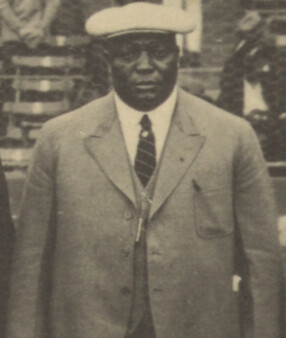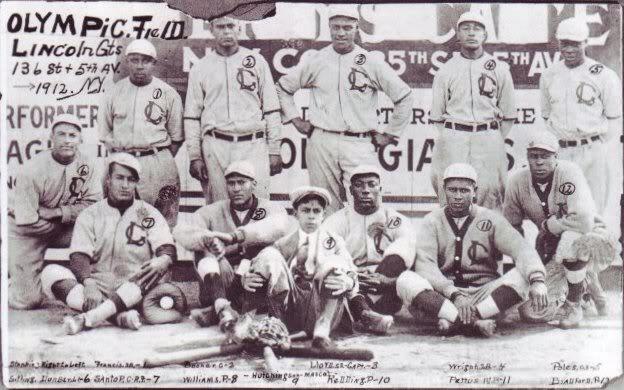1970 was a good year to be a baseball fan. Hank Aaron and Willie Mays were on legendary home run paces, Frank Robinson had recently become the first to win the MVP in both leagues, and Rod Carew had just won his first of 7 batting titles. The exploits of these and other black athletes were commonplace. It was then that another, less heralded event took place. Robert Peterson’s ground-breaking book, Only the Ball Was White, was published. For most fans, this was the introduction to a chapter of baseball history that had been sadly ignored.
Blacks had been involved in baseball since its origins. Moses Walker and his brother Welday had been members of the Toledo Blue Stockings of the American Association in 1886. Several other talented players like Frank Grant and George Stovey played in the high minors. But by 1888, racism would end integrated play for over a half century.
The Beginnings of the Negro Leagues
The Negro Leagues began informally at around this time. All-black teams formed and barnstormed around the country. Early entries included powerhouse teams like the Cuban Giants, Page Fence Giants, and the New York Lincoln Giants, who featured an all star line-up including Pop Lloyd, Louis Santop, Spot Poles, Smokey Joe Williams, and Dick “Cannonball” Redding.
Then in 1920, after many years of disorganization, Rube foster arrived on the scene. A dominant pitcher and baseball genius, Foster created the Negro National League, the first successful league in black baseball. With teams like the Chicago American Giants, St. Louis Stars, and Indianapolis ABC’s, the league offered black baseball a formal schedule, team contracts, and a World Series for the first time.
The NNL, which was comprised of teams from the Midwest, was followed soon by the formation of the Eastern Colored League in 1923, and brought together more top-notch clubs like the Atlantic City Bacharach Giants, Hilldale Daisys, and Baltimore Black Sox.
The NNL in Trouble
 When Rube Foster became ill in 1927, the Leagues faltered gradually until they had both folded by 1931. But by that time, other black baseball owners were moving to take up the mantle and keep the idea of Negro Leagues going. In 1933, Gus Greenlee of Pittsburgh led the way in creating the new Negro National League. Legendary teams like the Homestead Grays, Newark Eagles, and Greenlee’s Pittsburgh Crawfords were included in this venture. With the subsequent formation of the Negro American League, bringing together the new version of the Chicago American Giants, Memphis Red Sox, and the long-time independent Kansas City Monarchs, the Negro Leagues were truly in their golden age.
When Rube Foster became ill in 1927, the Leagues faltered gradually until they had both folded by 1931. But by that time, other black baseball owners were moving to take up the mantle and keep the idea of Negro Leagues going. In 1933, Gus Greenlee of Pittsburgh led the way in creating the new Negro National League. Legendary teams like the Homestead Grays, Newark Eagles, and Greenlee’s Pittsburgh Crawfords were included in this venture. With the subsequent formation of the Negro American League, bringing together the new version of the Chicago American Giants, Memphis Red Sox, and the long-time independent Kansas City Monarchs, the Negro Leagues were truly in their golden age.
Despite ongoing racial tension, especially during the barnstorming tours that most teams employed, some of the greatest players in baseball history took to the field under the banner of the Negro Leagues. Men like Satchel Paige, Oscar Charleston, and Cool Papa Bell were larger-than-life heroes to the fans who flocked to the stadiums to see them and cheer them on. Indicative of the segregated times, many of the Negro League stars would be compared to their white counterparts in the major leagues. Josh Gibson was known as the “Black Babe Ruth”, Buck Leonard became the “Black Lou Gehrig”, and so on. Many of the top performers in all of the Negro Leagues can be found in Diamond Mind Online’s reference section, “The Negro League Players”.
On August 28, 1945, Branch Rickey signed a young Kansas City Monarch infielder named Jackie Robinson to play with the Brooklyn Dodgers. Fighting through abuse and death threats, Robinson finally brought into the major leagues a fiery brand of intensity and free-wheeling play that had typified the Negro Leagues. Within a few years, major league baseball’s doors were slowly opening to allow the inclusion of a major portion of the population that had been excluded for nearly 60 years. As the signing of Jackie Robinson had signaled the end of the Negro Leagues, it also marked the beginning of a time that baseball could truly be called “America’s game”.





Leave A Comment